|
Related FAQs: Fungiids, Fungiid
Corals 2, Fungiid
Identification, Fungiid
Behavior, Fungiid
Compatibility, Fungiid
Selection, Fungiid Systems,
Fungiid Feeding, Fungiid Disease, Fungiid Reproduction, Stony/True Coral, Coral System Set-Up, Coral System Lighting, Stony Coral Identification, Stony Coral Selection, Coral Placement, Foods/Feeding/Nutrition, Disease/Health, Propagation, Growing Reef Corals, Stony Coral Behavior,
Related Articles: Large Polyp Stony
Corals, Stony or True Corals,
Order Scleractinia, Dyed
Corals,
/The Best Livestock For Your Reef Aquarium:
Plate Corals, Family
Fungiidae, Pt. 3
To: Part 1,
Pt. 2
|
|
|
By Bob Fenner
|
|
| Genus Herpolitha Eschscholtz 1825. Irregularly
elongate (X, Y, T shaped) colonies (not just individual polyps) with an raised
central area and axial furrow containing many expansive
mouths with mouths in or out. |
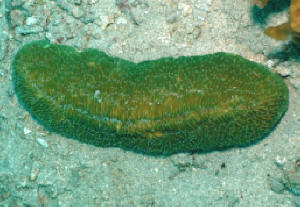
|
| Herpolitha limax (Houtthyn 1772).
Colonies become elongate with age, with rounded ends. Distinctive "bumped
up" mid area. Numerous
mouths inside and outside the axial furrow. Below, colonies in
Fiji. |
Bigger PIX:
The images in this table are linked to large (desktop size) copies.
Click on "framed" images to go to the larger size. |
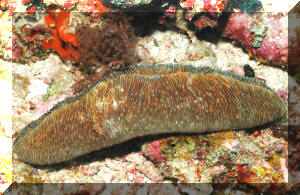
.JPG) |
Genus Lithophyllon Rehberg 1892. Colonies flat, bearing tentacular
lobes, with
one to many mouths. Free-living or attached.
| Lithophyllon lobata, (van der Horst 1021).
Peripheral corallites are distinctive w/ their wavy exsert septae-costae.
Usually just one central corallite. N. Sulawesi 2005. |
|
| Lithophyllon mokai Hoeksema 1989. Up to
three inches in diameter (80 mm.), encrusting/attached. Central corallite obvious. |
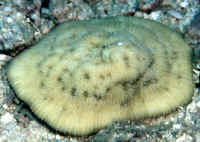 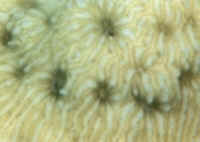
|
Genus Podabachia: Milne Edwards and Haime 1849. Leafy colonies, attached to
substrate; look like encrusting bowls or at times in tiered laminar growths
extending outward in plate like
pieces. Undersides costate.
| Podabacia crustacea (Pallas 1776); confluent
dentate (toothed) septae and costae, inclined toward edge. Laminar to bowl like, corallites
exsert, facing outward toward the growing edge. Usually brownish with
lighter margins. N. Sulawesi 2005. |

|
Bigger PIX:
The images in this table are linked
to large (desktop size) copies. Click on "framed" images
to go to the larger size. |
|
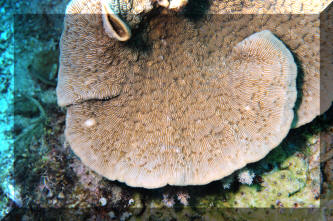
|
| Podabacia motuporensis Veron 1990; confluent
dentate (toothed) septae and costae. Laminar to bowl like, corallites
exsert, facing outward toward the growing edge. Usually brownish with
lighter margins. smaller corallites than P. crustacea. Red Sea 2019. Yeah,
outside the known/established geog. range. |
%20MD.JPG)
|
Bigger PIX:
The images in this table are linked to large (desktop size) copies. Click on
"framed" images to go to the larger size. |
|
%20MD.JPG)
|
Genus Polyphyllia Quoy & Gaimard 1833: Mobile colonies
whose form is a high arch shaped like a T, Y or X elongated. Septa look like small petals on close
inspection. Mouths all over upper side, axial furrow not easily detected. Septa
forming petal shape.
Bigger PIX:
The images in this table are linked
to large (desktop size) copies. Click on "framed" images
to go to the larger size. |
|
%20MD.JPG)
|
| Polyphyllia novaehiberniae (Lesson 1831).
Fused septa-costae that look like oblong depressions, in rows with
some running perpendicular to others. Numerous small tentacles look
like hair. Colonies below in Fiji. |
| Polyphyllia talpina (Lamarck 1801). Tapered
septa appearance. Long, numerous tentacles. Below, two aquarium
specimens and one in Pulau Redang, Malaysia. |
Bigger PIX:
The images in this table are linked to large (desktop size) copies.
Click on "framed" images to go to the larger size. |
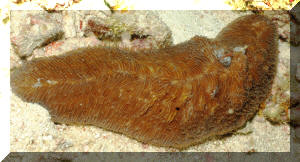
.JPG)
.JPG) |
Genus Sandalolitha Quelch 1884. Large, mobile roughly
circular colonies of heavy dome-shaped construction. Exsert, heavy
corallites face directly outward. Dentate costae.
| Sandalolitha robusta Quelch 1886.
Characteristic staggered arrangement of
corallites. Gilis/Lombok, Aquarium and N. Sulawesi
pix. |
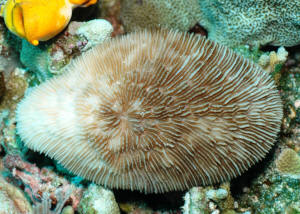
|
Bigger PIX:
The images in this table are
linked to large (desktop size) copies. Click on "framed"
images to go to the larger size. |
%20MD.JPG)
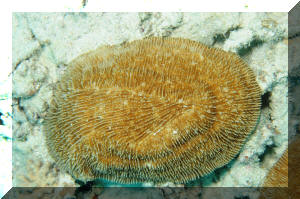 |
Bibliography/Further Reading:
Coral
Search
http://dpc.uba.uva.nl/cgi/t/text/get-pdf?c=ctz%3Bidno%3D8002a02 A
molecularly based phylogeny reconstruction of mushroom corals
(Scleractinia: Fungiidae) with taxonomic consequences and evolutionary
implications for life history traits
Borneman, Eric H. 2001. Aquarium Corals; Selection, Husbandry and
Natural History. Microcosm-TFH NJ, USA. 464 pp.
Fossa, Svein A. & Alf Jacob Nilsen. 1998 (1st ed.). The Modern
Coral Reef Aquarium, v.2 (Cnidarians). Bergit Schmettkamp Verlag,
Bornheim, Germany. 479pp.
Hoover, John. 1998. Hawai'i's Sea Creatures. A Guide to
Hawai'i's Marine Invertebrates. Mutual Publishing, Honolulu HI.
366pp.
Humann, Paul. 1993. Reef Coral Identification; Florida, Caribbean,
Bahamas. New World Publications, Inc. Jacksonville, FL.
239pp.
Vargas, Tony. 1997. Feature Coral: Fungia. FAMA 10/97.
Veron, J.E.N. 1986. Corals of Australia and the Indo-Pacific. U. of
HI press, Honolulu. 644 pp.
Veron, J.E.N. 2000. Corals of the World. Australian Institute of
Marine Science. Queensland, Australia. three volumes.
To: Pt.
1, Pt. 2

